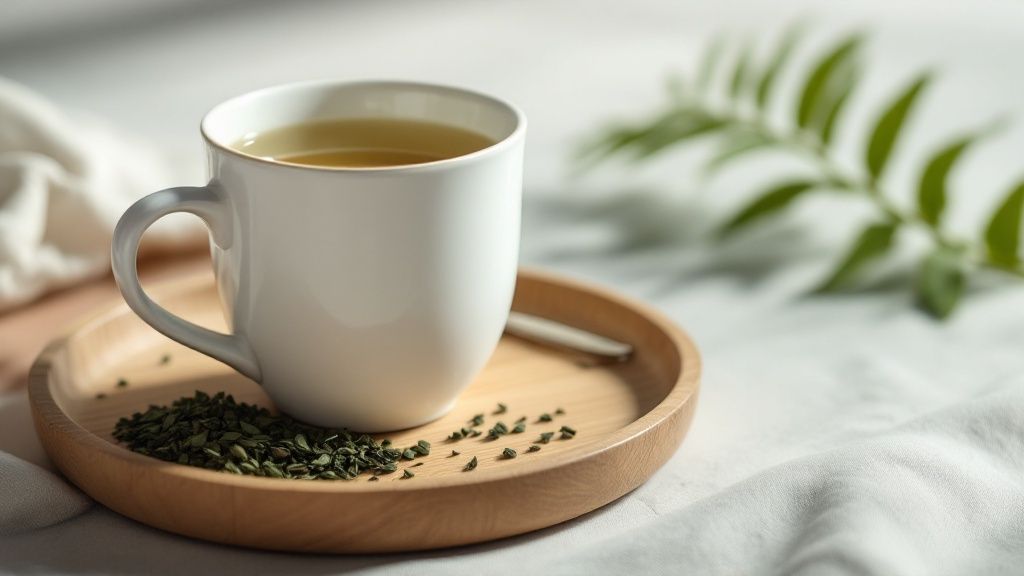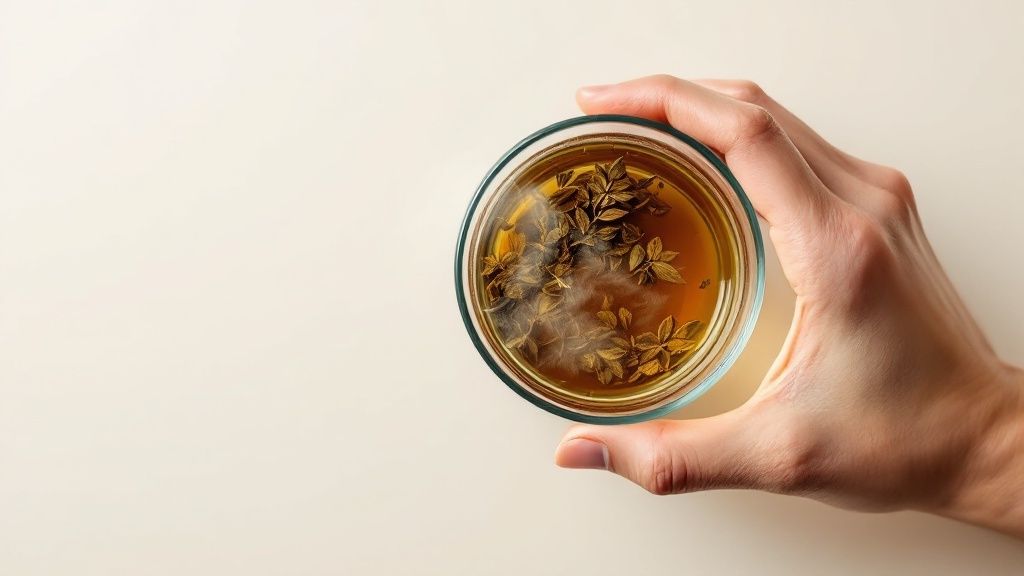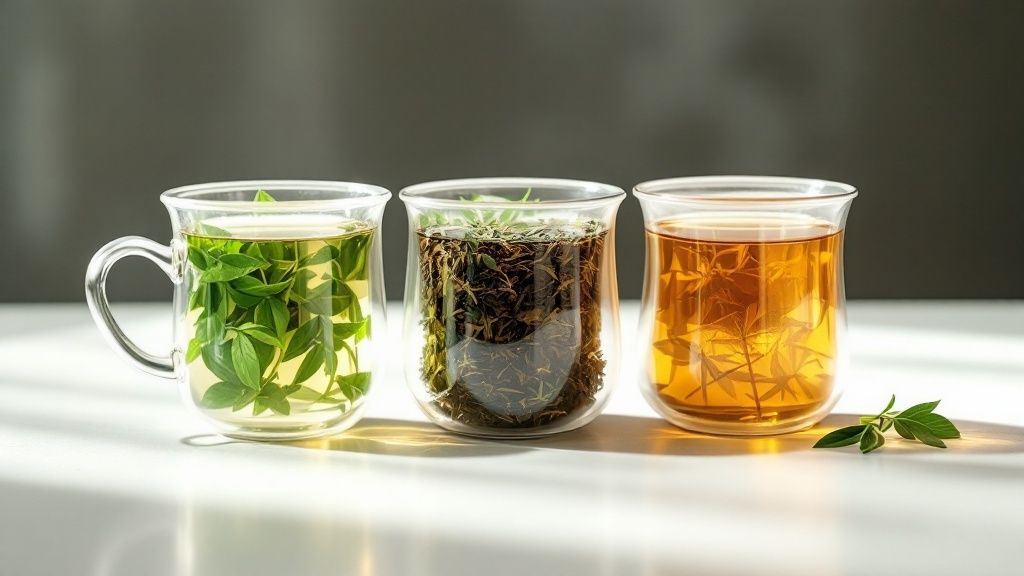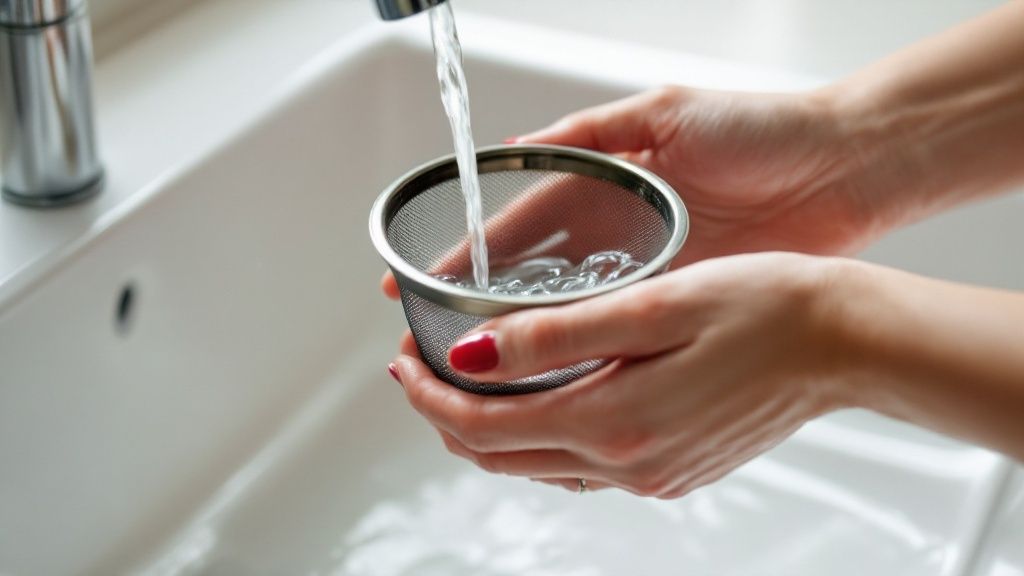Ever found yourself wondering what an infuser tea cup actually is? Think of it as your own personal brewing station, all neatly packaged into one clever design. It’s a mug, a removable filter, and a lid, all working together to make brewing loose-leaf tea incredibly simple.
The result? A far richer flavour and aroma than you could ever get from a standard tea bag.
Unlocking a World of Flavour with an Infuser Tea Cup
If you can picture a single-serve French press, but made just for tea, you've pretty much got it. At its heart, the infuser tea cup is a brilliant solution to a common problem: how to enjoy the incredible quality of https://www.jeevesandjericho.com/blogs/news/loose-leaf-tea without the faff of a teapot and strainer.
It’s all down to three simple parts working in harmony.
- The Mug: This is the cup itself, your sturdy vessel for that beautiful brew.
- The Infuser Basket: A removable, perforated basket that holds the tea leaves. It lets the hot water swirl around freely while keeping all the leaves neatly contained.
- The Lid: This clever little disc traps heat while your tea is steeping, and then—here’s the best bit—it doubles as a coaster for the wet infuser basket when you're done. No more drips!
Why It Elevates Your Tea Ritual
The real magic of an infuser tea cup is the space it gives the tea leaves to properly expand, or 'unfurl'. Tea bags, by contrast, are cramped spaces, often filled with low-grade tea dust. An infuser basket lets whole, beautiful leaves stretch out and breathe.
This movement is essential for releasing all the complex flavours, essential oils, and delicate aromas locked inside the leaf.
It’s the difference between a flat, one-note drink and a cup of tea that’s nuanced, aromatic, and full of character. You start to really appreciate the subtle notes of each different tea.
From Mundane to Mindful Brewing
Making the switch from tea bags to an infuser cup is one of those small changes that makes a huge difference. It encourages you to slow down and connect with what you’re drinking, letting you watch the leaves as they dance and steep. You're in complete control of the whole process.

This simple bit of kit is really a gateway to exploring the vast, exciting world of proper tea. They’re a practical, stylish addition to any home, often found among a wide range of kitchen tabletop essentials that just make daily routines feel a bit more special.
By giving you control and unlocking so much more flavour, this single cup quickly becomes an indispensable tool for any tea lover.
Comparing Infuser Tea Cup Materials

Choosing the material for your infuser cup isn't just about what looks nice on your kitchen counter. It genuinely shapes your daily brew, from how long it stays perfectly hot to the simple pleasure of watching the leaves unfurl.
Let's get to know the most common materials a little better. Understanding their unique quirks and charms will help you find the one that feels just right for your tea ritual.
The Classic Comfort of Ceramic
There's a reason ceramic is a go-to for tea mugs. It has a comforting, rustic weight that feels wonderful in your hands, perfect for a cosy afternoon cuppa. Think of it as the jumper of the mug world.
Its real strength is heat retention. The thick walls are brilliant at keeping your tea lovely and warm, which makes ceramic cups ideal for slow sippers who like to take their time without the brew going cold.
Just be mindful that ceramic can chip if you're not careful. It’s also a bit porous, so over time it might hold onto the memory of stronger teas like a rich Assam or fragrant Earl Grey.
The Visual Elegance of Glass
If you believe brewing should be a feast for the eyes, then glass is for you. There's something magical about watching the leaves dance and the water slowly bloom with colour. A glass infuser cup turns a simple brew into a beautiful spectacle.
Many of the best ones are made from borosilicate glass—the same tough stuff you find in science labs. This means it’s fantastic at handling sudden temperature changes, so you won’t have to worry about it cracking when you pour in boiling water.
The flip side is that glass doesn't hold heat quite as well as its ceramic or porcelain cousins. It can also be a bit fragile if dropped, making it less ideal for a chaotic kitchen or a busy office desk.
The Delicate Luxury of Porcelain
Porcelain is ceramic's more refined relative. Fired at much higher temperatures, it's thinner, smoother, and non-porous. It brings a real touch of elegance to your daily routine.
Because it’s non-porous, porcelain won’t absorb any flavours or aromas. This guarantees a pure, clean taste with every single brew, letting the subtle notes of your most delicate teas shine through without anything getting in the way.
It keeps tea warm beautifully, but its delicate nature does ask for a gentler touch. It’s a wonderful choice for those who really appreciate their teaware and don't mind handling it with a bit more care.
The Modern Durability of Stainless Steel
For a sleek, modern look combined with unbeatable practicality, look no further than stainless steel. These cups are pretty much indestructible, making them perfect for your commute, the office, or simply anyone who values durability. Plus, they’re a breeze to clean and won't stain or hang onto old flavours.
It's no surprise that stainless steel infusers are incredibly popular, grabbing about 58% of the market share. Their resilience and heat resistance really appeal to British tea drinkers who want things that work well and last. You can dive deeper into these market trends and the research on tea infuser preferences if you're curious.
The main thing to watch for is that the metal can get quite hot. Most good designs solve this with double-walled insulation or a silicone grip, but it's something to keep in mind.
A Quick Comparison of Infuser Tea Cup Materials
To help you weigh it all up, here’s a straightforward comparison of the key characteristics for each material. It's a handy guide to finding the best fit for your daily needs.
| Material | Heat Retention | Durability | Aesthetics | Best For |
|---|---|---|---|---|
| Ceramic | Excellent | Moderate | Rustic, cosy | Slow sipping and everyday comfort. |
| Glass | Fair | Moderate | Elegant, visual | Watching tea steep and appreciating colour. |
| Porcelain | Good | Low | Delicate, refined | Pure flavour and a luxurious experience. |
| Stainless Steel | Good (Double-Walled) | Excellent | Modern, sleek | Travel, durability, and easy maintenance. |
Ultimately, the right material comes down to what you value most—be it the visual experience, the purity of flavour, cosy comfort, or on-the-go toughness.
How To Choose Your Perfect Infuser Tea Cup

So, you're ready to find the perfect infuser cup. It's easy to get drawn in by a pretty pattern, but the real magic lies in the details—the little functional touches that turn a simple cup into your go-to daily brewing companion.
Think of it like choosing a favourite pen or a trusted kitchen knife. The right features can make the difference between a frustrating faff and a seamless, joyful ritual. Let's walk through what really matters so you can find a cup you'll love using every single day.
Consider Your Ideal Cup Capacity
First things first: how much tea do you actually drink in one sitting? It sounds simple, but getting the size right is crucial.
- Standard Mug (250-350ml): Perfect for that single, focused cup. Think of your morning brew at your desk or a quick afternoon pick-me-up. This size ensures you finish it while it's still perfectly hot.
- Large Mug (450ml+): Are you someone who likes to cradle a generous, comforting mug while you work or relax? Then a larger capacity is for you. These are brilliant for herbal infusions you want to sip over a longer period.
There’s no right or wrong answer here. A bigger mug gives you more tea, but it will cool down more slowly. A smaller one offers a more concentrated, hotter experience from start to finish. It’s all about what suits your routine.
Examine The Infuser Basket Details
The infuser basket is the heart of the whole operation. Its design has a huge impact on the final flavour in your cup, and believe me, not all infusers are created equal.
A well-designed infuser gives your tea leaves enough room to unfurl and the water plenty of space to circulate. This is the secret to unlocking a full-bodied, nuanced flavour that a cramped tea bag just can't match.
The mesh size is probably the most important thing to look at. A fine mesh is non-negotiable if you enjoy rooibos, fine herbal blends, or broken-leaf black teas. It stops those tiny bits from escaping and making your last sip gritty.
On the other hand, larger leaves like whole oolongs or white teas are happy with slightly wider holes, which can help water flow even better. If you want one cup that does it all, a high-quality, fine stainless steel mesh is your best bet. Of course, if you prefer a different brewing style, you could always explore a classic https://www.jeevesandjericho.com/products/teaball-infuser.
Pay Attention To Ergonomics And Design
Finally, it’s the little things that elevate the experience from good to great. Don't overlook the lid. A snug-fitting lid is essential for trapping heat while your tea steeps, giving you a hotter, more flavourful brew. As a bonus, it should be stable enough to double as a coaster for your wet infuser basket.
And what about the handle? Does it feel good in your hand? A comfortable, secure grip makes the cup feel balanced and a pleasure to hold, especially when it's full of hot tea. If you're hoping to match your new favourite mug with your existing setup, exploring diverse tableware collections is a great way to find inspiration and create a look you love.
A Simple Guide to Brewing the Perfect Cup

Right, let’s get to the best bit—actually using your new infuser cup. If you’ve always thought loose-leaf tea was something best left to the experts, think again. This simple bit of kit makes the whole process ridiculously easy and, most importantly, repeatable.
You're in complete control, every step of the way. Forget sad, bitter brews or watery, disappointing cups. We're about to walk through the simple steps to get it right, every single time.
Step 1: Prepare Your Cup and Leaves
First things first, a little trick that makes a huge difference: pre-warm your mug. Just pour a splash of hot water from your kettle, give it a swirl, and tip it out. This stops the cold ceramic from stealing heat, keeping your brew at a nice, steady temperature.
Next, it’s time to measure out your leaves. A good starting point is one rounded teaspoon per 250ml of water. Keep in mind that this isn't a hard and fast rule. Fluffy white teas might need a little more, while tightly rolled oolongs often need less.
Pop the leaves straight into the infuser basket and nestle it inside your warmed mug. You're all set.
Step 2: Master the Water Temperature
This is where the real magic happens. Using water at the right temperature unlocks your tea's true flavour. While boiling water is fine for a robust black tea or a herbal infusion, it will absolutely scorch delicate green and white teas, leaving you with a bitter, astringent taste.
Here’s a quick cheat sheet:
- Black Teas & Herbal Infusions: 95-100°C (Just off the boil)
- Oolong Teas: 85-95°C (Let the kettle stand for a minute after boiling)
- Green & White Teas: 75-85°C (Let it cool for 2-3 minutes)
Don't have a temperature-controlled kettle? No problem. Just boil the water and let it sit for a moment or two before you pour. It’s a simple pause that completely changes the final taste in your cup.
The Golden Rule of Brewing: Never skimp on water temperature or steeping time. These two things account for 90% of your tea's final flavour. Getting them right is what separates a decent cuppa from an unforgettable one.
Once the water is at the right temperature, pour it slowly over the leaves until the cup is full.
Step 3: Perfect Your Steeping Time
With the water in, pop the lid on top of your infuser cup. This simple action traps all that lovely heat and aroma, encouraging the leaves to properly unfurl and release their full flavour. Now for the final piece of the puzzle: timing.
Over-steeping is the number one culprit behind bitter tea. On the flip side, under-steeping leaves you with a weak, flavourless drink. You’re looking for that sweet spot where the taste is rich and full, but not harsh.
For a deeper dive into timings, you can learn more about how long you are supposed to brew tea in our dedicated guide. For now, here are some solid guidelines to get you started:
| Tea Type | Recommended Steeping Time |
|---|---|
| Green Tea | 1–3 minutes |
| White Tea | 2–4 minutes |
| Oolong Tea | 3–5 minutes (can be re-steeped) |
| Black Tea | 3–5 minutes |
| Herbal Infusions | 5–7 minutes |
Step 4: Remove and Enjoy
Once your timer dings, simply lift the infuser basket straight out. The genius of the infuser cup design is that it stops the brewing process instantly, giving you precise control.
Place the dripping basket onto the upturned lid—it now doubles as a handy little coaster, catching any drips. No mess, no fuss.
And that's it. Your tea is ready to be enjoyed. Take a moment to breathe in the aroma and admire the beautiful colour of a perfectly made cup.
Keeping Your Infuser Tea Cup in Top Condition
Think of your infuser tea cup like a favourite cooking pan – you wouldn't let old flavours hang around to spoil the next meal. It's exactly the same with tea. A quick, simple clean ensures every brew tastes fresh, pure, and exactly as it should.
After all, you don't want the ghost of this morning's strong English Breakfast haunting this afternoon's delicate Darjeeling. Let's walk through how to keep your cup and its infuser in sparkling condition, so you're always ready for that perfect cup.
Day-to-Day Cleaning for Different Materials
First things first, what's your cup made of? Different materials need slightly different care, though one rule always applies: a quick rinse right after you've finished is your best friend for preventing stains.
For ceramic, porcelain, and glass cups, a gentle wash with a bit of washing-up liquid and warm water is usually all it takes. If the cup says it's dishwasher-safe, go for it, but sticking it on the top rack is always a safer bet. Stainless steel is the tough one of the bunch and can almost always handle a spin in the dishwasher without any fuss.
Think of a daily rinse as hitting the reset button. It clears away the fresh tea oils and tiny leaf particles before they have a chance to build up and mess with the flavour of your next brew.
This tiny habit takes less than a minute but makes all the difference in the long run.
Tackling Those Stubborn Tea Stains
Even with the best intentions, you might start to see a brownish film building up over time. This is especially true if you're a fan of strong black teas. Those are just tannins, natural compounds in tea that love clinging to surfaces. Luckily, you don't need any harsh chemicals to get your cup looking brand new again.
There are two heroes hiding in your kitchen cupboards:
- Baking Soda: Just mix it with a little water to form a paste. Gently scrub the stained spots with a soft sponge or cloth, and its mild abrasive action will lift the stains without scratching your cup.
- Vinegar: For really tough marks, fill the cup with a 50/50 mix of white vinegar and warm water. Let it soak for an hour or two, then give it a good rinse.
These methods are cheap, effective, and completely non-toxic. Easy.
Getting the Infuser Basket Perfectly Clean
The fine mesh of an infuser basket is brilliant at its job, but it’s also a magnet for tiny bits of tea leaf and oils. A simple rinse often isn't quite enough to get everything out, which can lead to a clogged basket and a weak, disappointing brew.
To give it a proper deep clean, grab an old toothbrush or a small, soft brush. Once you've tipped out the used leaves, just give the mesh a gentle scrub inside and out under running water. This will dislodge any stubborn little particles.
For a really thorough job, you can soak the basket in the same baking soda paste or vinegar solution you used for the cup. This dissolves any lingering residue and oils, making sure water can flow through freely for a full-flavoured brew every single time. A clean basket is your ticket to a consistently great cup of tea.
Your Infuser Tea Cup Questions, Answered
Getting started with an infuser tea cup is a real game-changer for any tea lover. It's a simple bit of kit, but as with anything new, you're bound to have a few questions. We see the same queries pop up time and again, so we've gathered them here to help you get the most out of your new favourite mug from the very first brew.
Can I Use Tea Bags in an Infuser Tea Cup?
Well, you could, but it would be missing the point entirely. The whole idea behind an infuser tea cup is to give gorgeous, high-quality loose-leaf tea the space it needs to properly unfurl and release all those complex flavours and aromas.
Popping a tea bag inside the infuser basket is a bit like putting a sealed letter inside a post box—it's just an unnecessary extra step. The real magic happens when the tea leaves are free to dance around in the hot water, something a cramped tea bag simply doesn't allow for.
If you only have tea bags to hand, just take the infuser basket out and use the mug as normal. But to get the full, superior taste experience the cup was designed for, loose-leaf is always the way to go.
What's the Best Infuser Mesh Size?
The perfect mesh size really comes down to the kind of tea you drink most often. Not all tea leaves are the same shape or size, and the right infuser acts as the perfect gatekeeper, keeping the leaves where they belong while letting all that lovely flavour into your cup. Think of it like choosing the right sieve when you're baking.
- For Fine Teas: If your daily brew is a fine-particle tea like rooibos, some herbal infusions, or broken-leaf black teas, a micro-mesh infuser is a must. Those tiny holes are brilliant at stopping any sediment from sneaking into your brew, so you get a clean, smooth sip every time.
- For Large-Leaf Teas: Teas with bigger, whole leaves—like many oolongs, white teas, or premium Darjeelings—are happy with a basket that has slightly larger holes. This allows for brilliant water circulation, ensuring the leaves can fully hydrate and infuse properly.
If you love a bit of everything and want one cup that does it all, your best bet is to find a high-quality, fine stainless steel mesh. It strikes the perfect balance, containing small particles while still allowing for great water flow. It's the most versatile choice for any tea drinker.
Are Glass Infuser Cups Durable Enough for Daily Use?
It's a fair question! We tend to think of glass as being quite fragile. But the glass used for most modern infuser tea cups isn't your standard stuff. It’s typically made from borosilicate glass.
If that term rings a bell, it's because it's the same tough material used for lab equipment and classic Pyrex kitchenware. Its secret weapon is its incredible resistance to thermal shock.
What this means is that you can pour boiling water straight into a room-temperature borosilicate glass cup without worrying about it cracking or shattering. It's literally built to handle sudden, extreme temperature changes.
Of course, it's still glass—if you drop it from a height onto a tiled floor, it will likely break. But for normal, day-to-day use at home or in the office, a well-made borosilicate infuser cup is more than tough enough. Plus, you get to watch the leaves brew, which is a lovely little bonus.
How Do I Stop My Tea from Getting Bitter?
Ah, the dreaded bitter brew. We've all been there. The good news is that it’s almost always preventable. Bitterness in tea usually comes down to two things: steeping it for too long, or using water that’s too hot for the leaves.
An infuser cup gives you total control over both of these things, making it your best defence against a bitter cup. The moment your steeping time is up, just lift the basket out. This stops the brewing process instantly, preventing the leaves from over-extracting the tannins that cause that bitter taste.
Your lid is your best friend here—it doubles as a handy little coaster for the wet infuser, so you won't make a mess.
Just as important is your water temperature. Robust black teas can take boiling water, but delicate green and white teas will turn bitter and astringent if you scorch them. A green tea, for instance, shines when brewed with water that's cooled to around 80°C, revealing its sweet, grassy notes.
By managing your time and temperature, you can say goodbye to bitterness for good and unlock the true flavour of every tea you brew.
Ready to discover the perfect brew every time? Explore the exceptional collection of whole leaf teas at Jeeves & Jericho and find your new favourite. Visit us at https://www.jeevesandjericho.com to begin your flavour journey.


